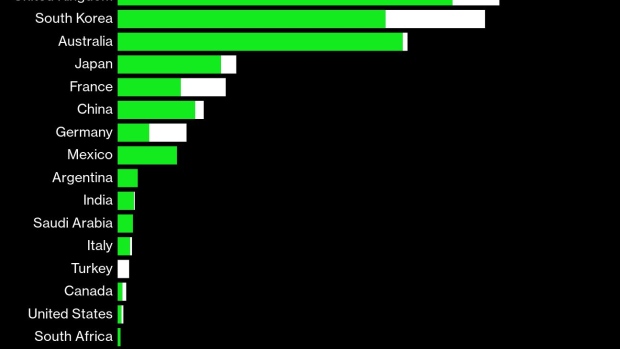Mar 10, 2021
The World Isn't Building Back Better After the Pandemic
, Bloomberg News

(Bloomberg) --
The exuberance of vaccine rollouts in rich countries is masking an ugly reality. Greenhouse gas emissions are already creeping higher than before the pandemic as economies come back to life.
That shouldn’t be a total surprise. Even as governments around the world have spent trillions of dollars to aid their nation’s recoveries, only a tiny fraction has gone toward initiatives that would also cut pollution.
Many politicians, including U.S. president Joe Biden, have adopted the phrase “build back better.” But they have yet to deliver on the promise. That’s the conclusion of a new report from the University of Oxford and the United Nations Environment Programme (UNEP). Researchers found that, out of the $14.6 trillion in spending announced by the 50 largest economies in 2020, only 2.5% has been for green activities.
And that limited stimulus isn’t evenly spread across the globe. “The vast majority of the green spending has been driven by only five countries,” said Brian O’Callaghan, project manager of the economic recovery project at the University of Oxford and a lead author of the report.
Much of the initial spending, about $11 trillion, was directed toward rescuing ailing firms, providing loans to small businesses and cash to individuals. Economists mostly agree that was necessary to avoid an even worse outcome.
But much of the rest of the stimulus money could have been better spent. “There was a rush to support companies without thinking through whether one could attach some green strings,” said Inger La Cour Andersen, executive director of UNEP.
These conditions could perhaps ensure that companies bailed out with taxpayer money were required to set emissions targets in line with, say, the Paris Agreement. It did happen a few times. Some European airlines, for example, were forced to cut short-haul flights when they accepted government funding during the pandemic.
While some economists argue that setting such rules can get in the way of recovery efforts, the vast majority, including many influential minds at central banks, argue that spending on green activities can help create just as many jobs as supporting high-emitting activities.
One reason for the failure may be that governments did not have “ready made pathways for green investments,” said Andersen. Countries can get better by learning from each other when it comes to what types of green spending are most effective.
That is why O’Callaghan’s team also launched the Global Recovery Observatory. It tracks stimulus spending across the world and has so far lodged more than 3,500 policies in its database. Using real-world examples, the group’s economic advisors can help policy makers shape green spending policies to suit their specific needs.
The tracker can also help civil-minded bodies hold governments to account. With real numbers to as a reference point, it will be easier to identify governments that claim to be pushing for a green recovery but aren’t actually doing enough.
The world economy shrank by as much as 3.5% in 2020, according to the International Monetary Fund. That’s the single largest drop in global gross domestic product since World War II, and it means the recovery will take a few years. So there's still time to push stimulus spending in a greener direction.
Akshat Rathi writes the Net Zero newsletter, which examines the world’s race to cut emissions through the lens of business, science, and technology. You can email him with feedback.
©2021 Bloomberg L.P.






